Finishing feed enhances LC-PUFAs in tails
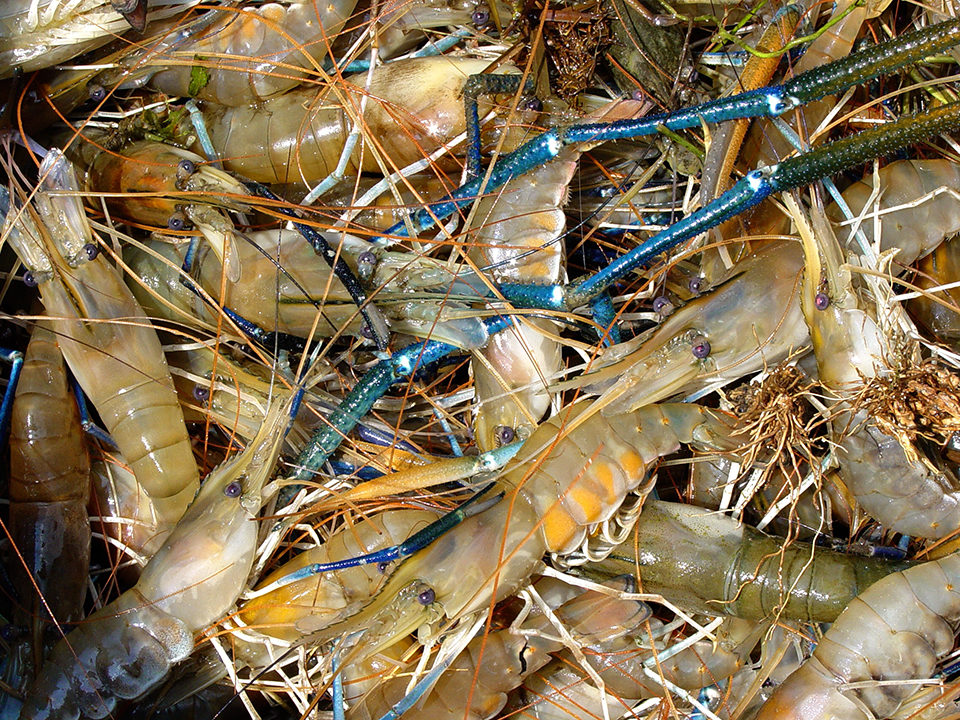
The highly fluctuating and ever-increasing costs of fishmeal and fish oil ingredients used in aquaculture diets, combined with concerns regarding their limited availability and sustainability, have stimulated research efforts throughout the past two decades to find suitable alternatives. Numerous feedstuffs have been evaluated as either partial or complete substitutes for both fishmeal and fish oil.
Often, however, these substitutions resulted in significantly lower growth – often without sufficient provision of essential long-chain polyunsaturated fatty acids (LC-PUFAs), particularly those of the omega-3 linolenic family, such as docosahexaenoic acid (22:6) and ecisopentaenoic acid (20:5).
Low-input culture
Low-input culture practices for freshwater prawns (Macrobrachium rosenbergii) were partially developed over the past 10 years to effectively manage growth and biological characteristics specific to this species of crustacean. Its growth rates decline as the stocking density and corresponding resident biomass in production ponds increase. In addition, males in the farmed populations are polymorphic, and the proportional presence of the slowest-growing and undesirable small morphs increases as stocking density increases.
Investigations of low-input culture ultimately resulted in conditions that optimized commercial net returns. Stocking at low densities of 24,700 to 29,640/hectare reduces the costs of stocking and feed required during the growing season.
Additionally, due to the inverse relationship between stocking density and mean harvest weight, larger harvested prawns command higher prices, thereby optimizing the net return. The low-input culture strategy also makes available a higher proportional contribution of natural productivity as food for each prawn to help satisfy nutrient requirements for growth.
Range cubes
The substantial pond-derived nutrients allow for the successful use of range cubes, a commercially available livestock feed supplement, as part of the low-input production strategy. The range cubes have a protein content derived from plant feedstuffs that ranges from 20 to 22 percent, and contain no fishmeal or fish oil. Fatty acid analysis revealed no detectable LC-PUFA in the range cubes fed to the prawns.
However, production achieved with range cubes under low-input pond culture conditions has been comparable to that achieved when a commercially available prawn feed containing fishmeal and fish oil was fed. The prawn feed costs approximately 100 percent more than range cubes.
Required nutrients, particularly LC-PUFAs, are presumably derived from the consumption of pond organisms such as insect larvae. Levels of LC-PUFA are apparently sufficient to satisfy the essential fatty acid requirements of this species, whose LC-PUFA requirements are approximately 0.08 percent of the diet, in comparison to 0.5 to 1.0 percent for marine shrimp.
However, levels of LC-PUFA in the tail muscles of prawns fed the range cubes were lower than those found in prawns fed the nutritionally complete, commercial prawn feed. Therefore, the question arose as to whether the tissue levels of the LC-PUFAs could be enhanced by a cost-effective strategy using prawn feed for a short period before harvest.
The idea of improving the nutritional appeal of the shrimp while saving on the costs of feeding a diet containing fishmeal and/or fish oil for the entire growing season was subsequently investigated in two experiments conducted in sequential growing seasons.
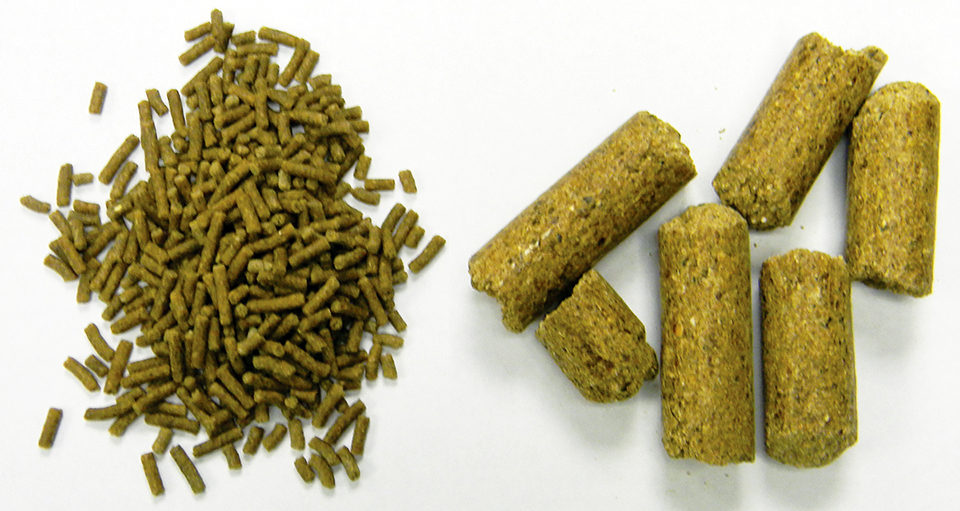
Initial feeding test
For the first experiment, prawns were stocked at 24,700/ha in three treatments. The prawns were fed either the range cubes or the prawn feed exclusively for the entire 18-week growing season. A third treatment consisted of the feeding of range cubes for the first 12 weeks, followed by a six-week period during which a nutritionally complete commercial prawn feed containing LC-PUFAs from menhaden fish oil and fishmeal was fed.
The prawn feed was fed at one-half of the feeding rate of the range cubes in the interest of reducing costs, while recognizing the prawn feed was nutritionally complete. At the end of the growing season, there was no difference in growth or survival among the three treatments. The qualitative LC-PUFA content of the tail muscle tissue of prawns harvested from all three treatments was very similar.
The quantitative LC-PUFA content of prawns fed the commercial diet for either the entire growing season or the last six weeks was essentially the same and notably higher than that found in prawns fed the range cubes exclusively. Expressed as percent of total fatty acids, the 20:5 omega-3 and 22:6 omega-3 levels for prawns harvested from the pre-harvest feed change group were 6 and 2.5 percent, respectively, higher than those observed for the prawns fed only range cubes.
LC-PUFA enhancement A second, follow-up experiment was conducted to determine whether the amount of time necessary to enhance the LC-PUFA composition by feeding the prawn feed could be reduced to three or two weeks prior to harvest. Range cubes were again fed exclusively as one treatment, and prawn feed was fed at half the rate of the range cubes for the period prior to harvest.
Again, there was no difference in survival or total production among the treatments, and the relative proportions of the LC-PUFA when feeding the prawn diet for six weeks prior to harvest were the same as those observed the previous year. However, for the three-week and two-week pre-harvest feeding treatments, the LC-PUFA levels were 2.5 and 1.1 percent less (expressed as percent of total fatty acids) for 20:5 omega-3 and 22:6 omega-3 (Table 1).
D'Abramo, PUFA and LC-PUFA composition, Table 1
| Feed Fatty Acid | Feed Range Cubes | Feed Prawn Feed | Tail Muscle Tissue Range Cubes Entire Growing Season 2009 | Tail Muscle Tissue Range Cubes Entire Growing Season 2010 | Tail Muscle Tissue Prawn Feed Entire Growing Season 2009 | Tail Muscle Tissue Prawn Feed Pre-Harvest 6 Weeks 2009 | Tail Muscle Tissue Prawn Feed Pre-Harvest 6 Weeks 2010 | Tail Muscle Tissue Prawn Feed Pre-Harvest 3 Weeks 2010 | Tail Muscle Tissue Prawn Feed Pre-Harvest 2 Weeks 2010 |
|---|
Feed Fatty Acid | Feed Range Cubes | Feed Prawn Feed | Tail Muscle Tissue Range Cubes Entire Growing Season 2009 | Tail Muscle Tissue Range Cubes Entire Growing Season 2010 | Tail Muscle Tissue Prawn Feed Entire Growing Season 2009 | Tail Muscle Tissue Prawn Feed Pre-Harvest 6 Weeks 2009 | Tail Muscle Tissue Prawn Feed Pre-Harvest 6 Weeks 2010 | Tail Muscle Tissue Prawn Feed Pre-Harvest 3 Weeks 2010 | Tail Muscle Tissue Prawn Feed Pre-Harvest 2 Weeks 2010 |
|---|---|---|---|---|---|---|---|---|---|
| 18:2 | 44.81 | 22.09 | 27.41 | 26.05 | 15.43 | 21.73 | 17.56 | 18.38 | 21.42 |
| 18:3 | 2.42 | 3.77 | 2.58 | 2.08 | 2.54 | 3.22 | 1.99 | 2.53 | 2.33 |
| 20:4 | * | 1.31 | 5.14 | 6.06 | 3.73 | 4.07 | 4.97 | 6.46 | 5.30 |
| 20:5 | * | 7.96 | 4.26 | 4.19 | 12.59 | 10.15 | 10.17 | 7.68 | 7.68 |
| 22:5 | * | 1.55 | 0.59 | 0.82 | 0.68 | 0.91 | 1.11 | 0.86 | 0.59 |
| 22:6 | * | 3.69 | 0.27 | 0.39 | 2.83 | 2.38 | 2.65 | 1.68 | 1.70 |
Table 1. PUFA and LC-PUFA composition (% of total fatty acids) of feed and tail muscle tissues of prawns fed either range cubes, prawn feed exclusively or a combination of range cubes and prawn feed.
This decline for the two- and three-week pre-harvest treatments could be the result of a lower amount of food consumed, corresponding to a decline in pond water temperatures as the growing season came to an end. The periods of time prior to harvest when pond temperatures were recorded as greater than 27 degrees-C at midday were 71.8, 54.2 and 35.3 percent for the six-week, three-week and two-week pre-harvest treatments, respectively.
Perspectives
The experiments indicated that culture of species with comparatively low LC-PUFA requirements can be achieved on diets with no fishmeal or fish oil and lower levels of crude protein under low-density conditions. Since response to the dietary LC-PUFAs and their corresponding accumulation in the prawn tissue were very rapid, the levels of these fatty acids that are important in human nutrition were effectively increased in the tail muscle during the last third of the growing season at a very low increase in total feed expense. In fact, for the six-week pre-harvest application of prawn feed, the cost of the harvested prawns increased by only $0.24/kg.
To meet consumer demand, LC-PUFA levels could be enhanced in freshwater prawns or other species by providing a “finishing” feed of the same ingredient composition but with a fish oil or comparatively effective oil of suitable LC-PUFA content added or sprayed on. The six-week duration of this pre-harvest feeding is effective at temperate latitudes and possibly could be reduced for warmer water temperatures, when rates of consumption would be higher.
(Editor’s Note: This article was originally published in the May/June 2012 print edition of the Global Aquaculture Advocate.)
Now that you've reached the end of the article ...
… please consider supporting GSA’s mission to advance responsible seafood practices through education, advocacy and third-party assurances. The Advocate aims to document the evolution of responsible seafood practices and share the expansive knowledge of our vast network of contributors.
By becoming a Global Seafood Alliance member, you’re ensuring that all of the pre-competitive work we do through member benefits, resources and events can continue. Individual membership costs just $50 a year.
Not a GSA member? Join us.
Author
-
Louis R. D’Abramo, Ph.D.
Department of Wildlife, Fisheries and Aquaculture
Mississippi State University
Box 9690
Mississippi State, Mississippi 39762 USA
Tagged With
Related Posts

Aquafeeds
A look at protease enzymes in crustacean nutrition
Food digestion involves digestive enzymes to break down polymeric macromolecules and facilitate nutrient absorption. Enzyme supplementation in aquafeeds is a major alternative to improve feed quality and nutrient digestibility, gut health, compensate digestive enzymes when needed, and may also improve immune responses.
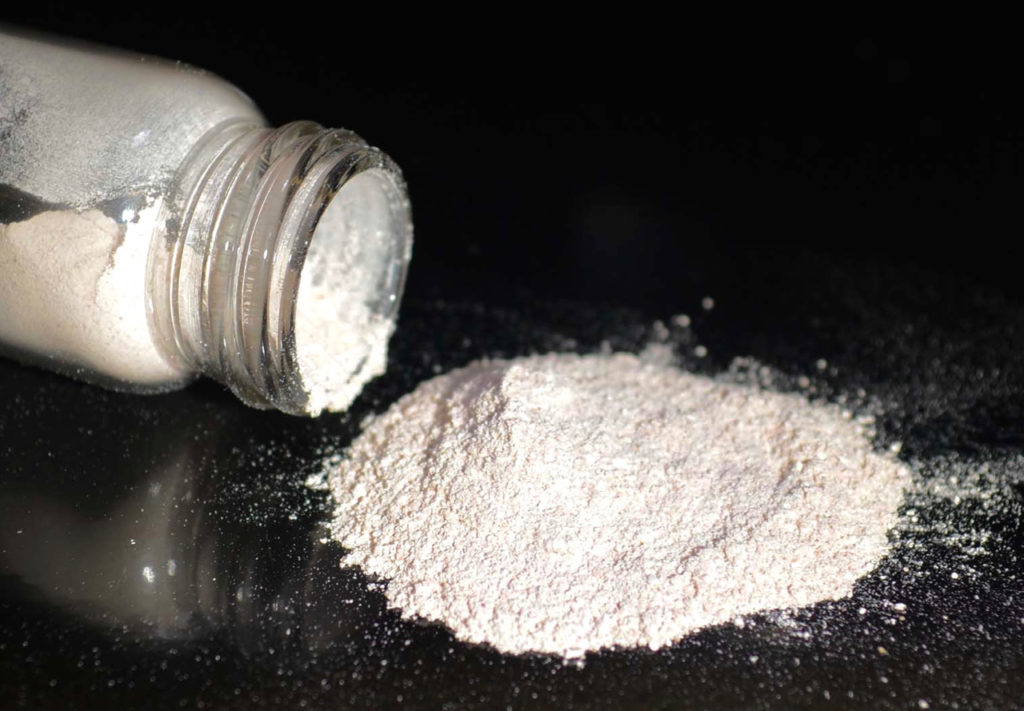
Aquafeeds
A new nutrient for aquaculture, from microbes that consume carbon waste
Biotechnology firm NovoNutrients aims to produce a line of nutraceutical aquafeed additives as well as a bulk feed ingredient that can supplement fishmeal. Its process includes feeding carbon dioxide from industrial gas to a “microbial consortium” starring hydrogen-oxidizing bacteria.
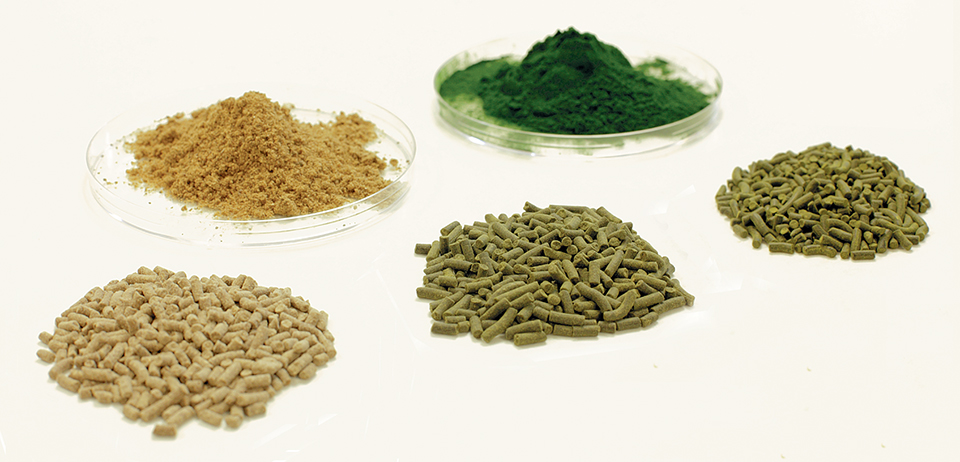
Aquafeeds
Algae alternative: Chlorella studied as protein source in tilapia feeds
Chlorella and other species have potential as protein sources in aquafeeds. In trials with tilapia fry raised in a recirculating system, the fish received a fishmeal-based control diet or feeds with portions of the fishmeal replaced by Chlorella.
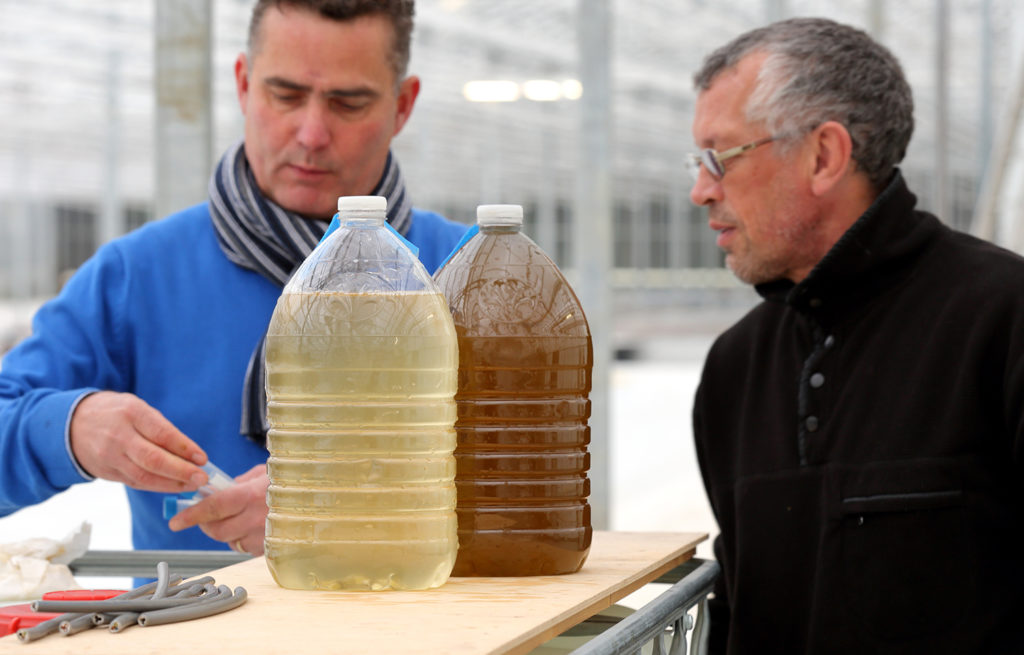
Innovation & Investment
Algae innovators aim to freeze out early-stage shrimp losses
A greenhouse in Belgium believes its innovative shrimp feed product, made from freeze-dried microalgae, packs the necessary nutrients for the crustacean’s most vulnerable life stage: the first three days of its life.



